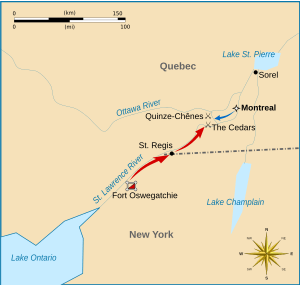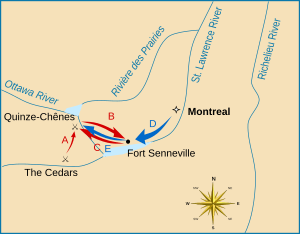Battle of the Cedars facts for kids
Quick facts for kids Battle of the Cedars |
|||||||
|---|---|---|---|---|---|---|---|
| Part of the American Revolutionary War | |||||||
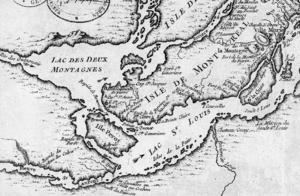 1764 map showing western part of the island of Montreal (Isle de Mont Real), with the growing town centred on Fort Ville Marie in the upper right and the Cedars (overlooking Rapide du coteau des Cedres) in the map's lower left corner. |
|||||||
|
|||||||
| Belligerents | |||||||
Iroquois |
Canadian sympathizers |
||||||
| Commanders and leaders | |||||||
| George Forster | Isaac Butterfield (POW) Henry Sherburne (POW) Benedict Arnold |
||||||
| Strength | |||||||
| 40 British regulars 11 Canadian militia 204 Iroquois |
Cedars: 400 regulars and militia Quinze-Chênes: 100 regulars and militia |
||||||
| Casualties and losses | |||||||
| Cedars: none Quinze-Chênes: 1 killed, 4–5 wounded |
Cedars: 5–6 casualties, rest captured | ||||||
| Official name: Battle of the Cedars National Historic Site of Canada | |||||||
| Designated: | 1928 | ||||||
The Battle of the Cedars (French: Bataille des Cèdres) was a series of small fights during the American Revolutionary War. This war was when the American colonies fought for their independence from Great Britain. These battles happened in May 1776 near a place called the Cedars, about 45 kilometers (28 miles) west of Montreal, in what was then British North America.
The fights were part of the Continental Army's attempt to take over Canada. American soldiers faced a small group of British troops, who were joined by many Native American warriors (mostly from the Iroquois tribes) and some local Canadian fighters.
Brigadier General Benedict Arnold was in charge of the American forces in Montreal. He sent some troops to the Cedars because he heard that British and Native American forces were preparing to attack. On May 19, the American soldiers at the Cedars had to surrender after a fight with a combined British and Native American force led by Captain George Forster.
Later, American soldiers who were on their way to help were also captured on May 20 after a short battle. All the captured soldiers were eventually set free after leaders from both sides talked things over. The agreement said that the Americans would release an equal number of British prisoners. However, the American government (the Second Continental Congress) did not agree to this deal, so no British prisoners were released.
Understanding the Battle of the Cedars
The Battle of the Cedars was a series of small but important events during the early part of the American Revolutionary War. It showed how complicated the war was, involving not just American and British soldiers, but also different Native American tribes and local Canadians.
Where is the Cedars?
The Cedars is located on the north side of the Saint Lawrence River. It's about 45 kilometers (28 miles) southwest of modern Montreal. This spot was very important because of the fast-moving waters (rapids) in the Saint Lawrence River. Boats had to be carried around these rapids, making the Cedars a key stopping point for anyone traveling by river to or from Montreal.
Montreal During the War
In September 1775, the American Continental Army invaded the British Province of Quebec. They captured Montreal without a fight on November 13. After taking Montreal, the American general, Richard Montgomery, left a group of soldiers there and moved on to attack Quebec City.
However, the Americans struggled to manage Montreal. Relations between the American soldiers and the local people became difficult. One big reason was that the Americans stopped trade with Native American groups. This trade was very important for Montreal's economy, and stopping it upset many people.
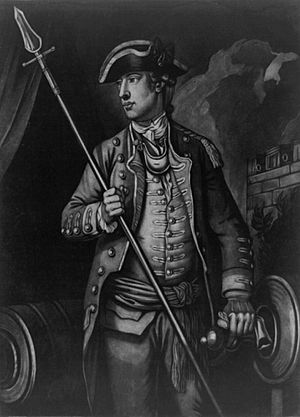
After a tough loss at the Battle of Quebec in late 1775, General David Wooster took charge in Montreal. He heard rumors that British troops and Native Americans were planning attacks from the west. To protect Montreal, Colonel Moses Hazen sent 400 American soldiers, led by Colonel Timothy Bedel, to the Cedars in early April. Lieutenant Isaac Butterfield arrived first on April 26 and began building a wooden fort with two cannons. Colonel Bedel and the rest of his soldiers arrived on May 6.
British and Native American Preparations
A British agent named Claude-Nicolas-Guillaume de Lorimier traveled west to a place called Oswegatchie. There, he met Captain George Forster, who was leading a British army unit. Lorimier suggested gathering Native American warriors to attack the Americans in Montreal from the west. Forster agreed. Lorimier then went to Akwesasne, where he recruited 100 Mohawk warriors.
At Fort Niagara in early May, a British captain named John Butler met with several hundred Native American tribesmen, mostly from the Iroquois nations. Butler convinced more than 50 warriors from the Seneca, Cayuga, and Onondaga tribes to join the British side. It's not clear if these specific warriors fought at the Cedars, but other Native American groups did join the British.
The Battle Begins
Captain Forster left Oswegatchie on May 12 with about 40 British soldiers, 10 Canadian fighters, and 160 Iroquois warriors. They gathered more Iroquois on their way. By May 17, Forster received reports about the American soldiers at the Cedars. The Native American warriors were worried about the number of American troops. However, news that the Americans were retreating from Quebec encouraged them to continue.
On May 15, Colonel Bedel left the Cedars, leaving Lieutenant Butterfield in charge of the fort. Bedel later said he left to meet with friendly Native American groups. He returned to Montreal and reported that a large force of British and Iroquois soldiers was approaching. Hearing this, Colonel John Paterson sent Major Henry Sherburne with 140 men to help at the Cedars. General Arnold, who was away, rushed back to Montreal to organize more help.
Fighting at the Cedars Fort
Forster's forces arrived near the American fort on May 18 and demanded that the Americans surrender. Butterfield asked to leave with his weapons, but Forster refused. Both sides began to fire at each other. During the fighting, Forster learned that Major Sherburne's American reinforcements had crossed the Ottawa River but then retreated.
This news made the British and Native American forces attack harder the next day. More Canadian fighters joined Forster. Then, Forster heard that Sherburne was advancing again. Butterfield, not knowing this, surrendered the fort. The agreement said that the captured American soldiers would be safe. However, the Iroquois warriors took many supplies from the fort and some personal items from the prisoners.
Fighting at Quinze-Chênes
Major Sherburne reached Fort Anne on May 17. A scout he sent across the Ottawa River was captured. The scout was allowed to tell Sherburne that 500 Native Americans had surrounded the fort at the Cedars. Because of this, Sherburne decided to wait before crossing the river and asked Montreal for more help.
Sherburne decided to advance on May 20. He landed about 100 of his men at Quinze-Chênes, about 16 kilometers (10 miles) from the Cedars. When Forster heard about this, he ordered Lorimier to take 100 Native American warriors to stop Sherburne. Lorimier gathered 80 warriors. Sherburne's troops marched directly towards Lorimier's advancing force. They fought for about 40 minutes. Sherburne, thinking he was attacked by a much larger force, surrendered.
The Iroquois warriors considered these new captives as war prizes. They wanted to harm some of them to get revenge for their own losses. Captain Forster had to pay a ransom to stop this. However, the Iroquois still took almost all the clothes from the prisoners.
General Arnold's Response
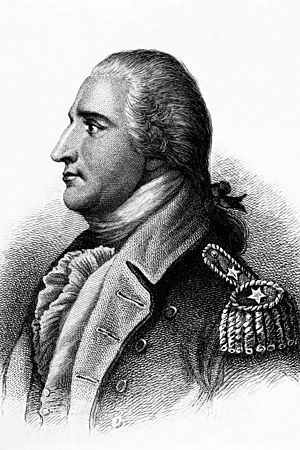
After his victories, Forster moved his forces and all the prisoners to Quinze-Chênes. He then advanced to Fort Senneville, a fortified area on Montreal island. Meanwhile, General Arnold gathered most of the remaining American soldiers in Montreal. By May 24, he had about 450 men and was ready to fight at Lachine, south of the city.
Forster started to advance towards Lachine, but his scouts told him about Arnold's strong position. He also heard that Arnold was going to get many more soldiers, possibly 1,500 to 2,000 men. So, Forster decided to retreat back to Quinze-Chênes.
When Arnold's scouts reported Forster's retreat, Arnold chased after him. He reached Fort Senneville (which he later burned) on May 26, just as Forster's men were landing on the other side of the river at Quinze-Chênes. Arnold sent a group of friendly Mohawk warriors with a message to Forster. He demanded that Forster release the prisoners and threatened to destroy Native American villages if any prisoners were harmed. Forster replied that he would let his Native American allies harm the prisoners if Arnold attacked. Arnold tried to cross the Ottawa River with some of his men, but Forster used the captured cannons to push them back.
Arnold held a meeting with his officers to decide what to do. He wanted to launch a surprise attack the next morning. However, Colonel Hazen, who had a lot of experience fighting Native Americans, argued against it. The officers voted against Arnold's attack plan.
Early on May 27, a boat crossed the river carrying Major Sherburne and Forster's deputy. Forster, whose forces were smaller because some Native American warriors had gone home, had negotiated a prisoner exchange with Sherburne and Butterfield. After more talks, Arnold and Forster agreed to the terms. The American prisoners were returned to Arnold on May 30.
What Happened Next
The Americans never kept their promise to release British prisoners. The Second Continental Congress (the American government) refused the agreement. They accused Forster of treating American prisoners badly by letting Native Americans take their belongings. Some reports at the time wrongly claimed that many American soldiers were killed by Native Americans. These reports were often exaggerated and not true.
General Arnold initially blamed Colonel Bedel for the defeat. Both Bedel and Butterfield were removed from their commands. They faced a military trial in August 1776. Both were found guilty and removed from the army. However, Bedel continued to help the American cause as a volunteer. After a major American victory in 1777, he was given a new position in the army.
Today, the area where some of these battles happened is a National Historic Site of Canada. It was recognized in 1928.
See also
 In Spanish: Batalla de Los Cedros para niños
In Spanish: Batalla de Los Cedros para niños


